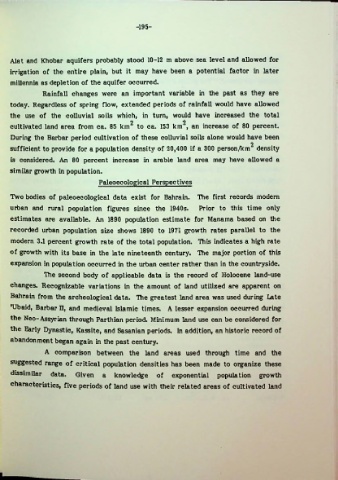Page 219 - Life & Land Use on the Bahrain Islands (Curtis E Larsen)
P. 219
-195-
Alat and Khobar aquifers probably stood 10-12 m above sea level and allowed for
irrigation of the entire plain, but it may have been a potential factor in later
millennia as depletion of the aquifer occurred.
Rainfall changes were an important variable in the past as they are
today. Regardless of spring flow, extended periods of rainfall would have allowed
the use of the colluvial soils which, in turn, would have increased the total
2 2
cultivated land area from ca. 85 km to ca. 153 km , an increase of 80 percent.
During the Barbar period cultivation of these colluvial soils alone would have been
sufficient to provide for a population density of 20,400 if a 300 person/km density
is considered. An 80 percent increase in arable land area may have allowed a
similar growth in population.
Paleoecological Perspectives
Two bodies of paleoecological data exist for Bahrain. The first records modem
urban and rural population figures since the 1940s. Prior to this time only
estimates are available. An 1890 population estimate for Manama based on the
recorded urban population size shows 1890 to 1971 growth rates parallel to the
modern 3.1 percent growth rate of the total population. This indicates a high rate
of growth with its base in the late nineteenth century. The major portion of this
expansion in population occurred in the urban center rather than in the countryside.
The second body of applicable data is the record of Holocene land-use
changes. Recognizable variations in the amount of land utilized are apparent on
Bahrain from the archeological data. The greatest land area was used during Late
RJbaid, Barbar n, and medieval Islamic times. A lesser expansion occurred during
the Neo-Assyrian through Parthian period. Minimum land use can be considered for
the Early Dynastic, Kassite, and Sasanian periods. In addition, an historic record of
abandonment began again in the past century.
A comparison between the land areas used through time and the
suggested range of critical population densities has been made to organize these
dissimilar data. Given a knowledge of exponential population growth
characteristics, five periods of land use with their related areas of cultivated land
L

